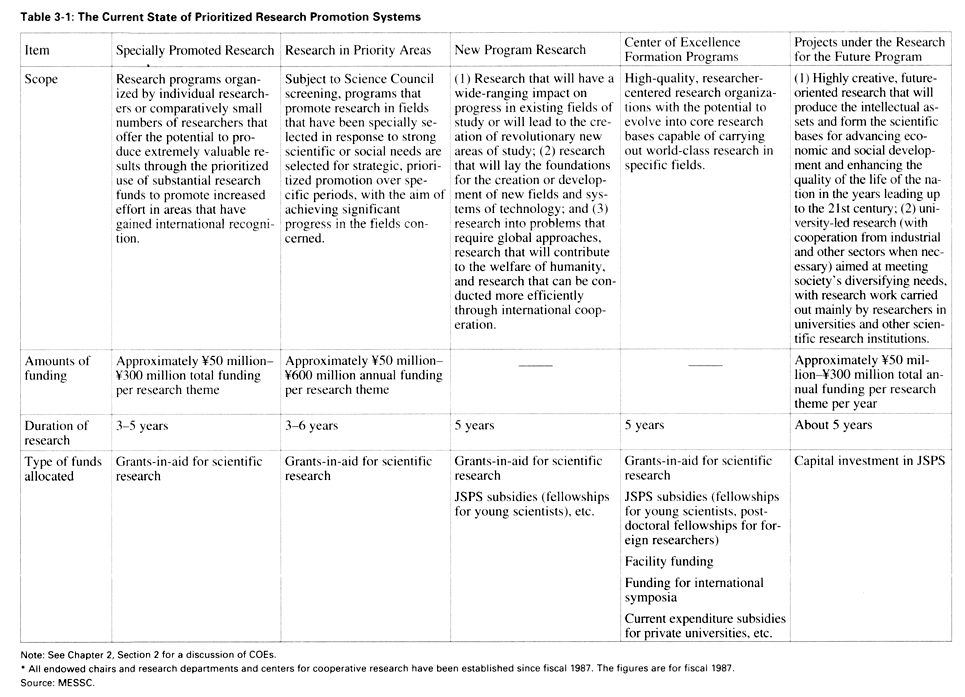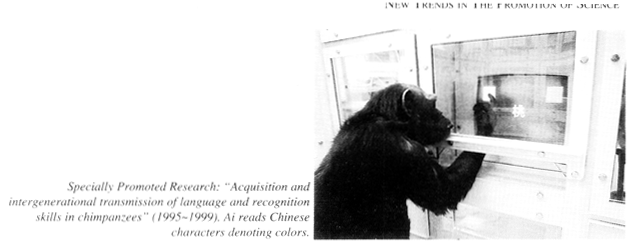| Home > Policy > White Paper, Notice, Announcement > White Paper > JAPANESE GOVERNMENT POLICES IN EDUCATION, SCIENCE, SPORTS AND CULTURE 1997 > Scientific Research Chapter 3 Section 1 2 | ||
The range of possible systems for prioritized research is wide and varied. The leading example is the promotion of large-scale research ("big science"), the funding of which is covered by the system for research in priority areas described in Chapter 2, Section 1, 2, (4) . In the Science Council's 1992 report, large-scale research was defined as "a large-sized program to be promoted by intensive channeling of a considerably large amount of research resources including researchers, research funds, research facilities and equipments, etc, within a specified period," with accelerator science, space science, astronomy, and fusion research all listed as examples. This section focuses on prioritized promotion systems for research programs that cannot be classified as large-scale, long-term projects but still need intensive promotion on a significant scale within certain time frames. As shown in Table 3-1 , the categories covered are
Items (4) and (5) have already been discussed, items (1), (2), and (3) are examined below.
The Specially Promoted Research category of grants-in-aid for scientific research was instituted in fiscal 1982 after a trial period that began in FY1979. It is an important research promotion system designed to encourage original, pioneering basic research in Japan. Under this system, substantial research funds are provided over periods of 3-5 years for research programs implemented by individuals or relatively small groups of researchers. The goal defined for the program when it was established was "to provide prioritized subsidization for very outstanding research that is at the leading edge of international work in the field and has the potential to yield highly valuable results." Approximately 10 programs are s elected each year on the basis of rigorous screening.


Research Themes for Specialty Promoted Research Programs that Start in Fiscal 1997 Physical and Engineering Sciences Formation and evaluation of quantum dot structures in high-density semiconductors Coherent radiation of micro-bunch electronics Exploring dark matter axions Electronic physical control in wide-gap semiconductors and its application to energy electronics Creation of biological motion elements using polymer gels Formation of metal reaction fields with a view to activation of specific small molecules Chemical research relating to plant senses and motion Biology Analysis of formation differentiation and molecular structures of coronary blood vessels Research into motor-protein functions using protein engineering and holographic cryo-electron microscopy Molecular-cellular biological research into abnormalities in renal membrane transportation Comparative molecular biological research concerning peptide hormone receptors involved in adjustment of body fluids and circulation Functions of cofilin as an actin adjustment protein |
Research on Priority Areas is another category of grants-in-aid for scientific research. It was introduced in fiscal 1987 in response to a proposal from the Science Council in July 1985. The system is designed to encourage efficient research by combining fluid, flexible research organizations and funding in areas of scholarship in which sophisticated research tools and methods already exist. On the basis of requests from groups of researchers, funds in this category are used to provide timely support in advanced fields that have been targeted for further progress. The level of funding ranges from \50 million to \600 million per fiscal year and is provided over periods of 3-6 years, depending on the content of the research and current trends in the fields concerned. There is strong demand among researchers for Research on Priority Areas funds. In fiscal 1997 there were 178 applications, of which 23 were selected.
Research on Priority Areas that Starts in Fiscal 1997 The development of the mind: The mechanisms of recognition growth Scientific research on the origins of the Japanese people and culture Micro-region magnetism and its transmission Formation and polar reaction of structural limitation fields New organic chemical phenomena: New axes for the carbon shared linkage formation based on multielement cooperation effects The chemistry of interelement fusion Creation of a super-biosystem using sugar chain molecules with advanced recognition Near-field nano-optics: The chemistry and engineering of isolated photons in microspaces Analysis of microscopic mechanisms in phase transformations with a view to the control of material organization Carbon alloys: Space control and the development of functions in carbon materials Developments of new semiconductor structures through spin control Research into the structural principles of software with development functions Non CP-storage physics Development of physical environmental processes with a view to the achievement of zero emissions Biological functions and designer molecules Molecular basis for the control of photosynthesis in individual plants Molecular basis of vertebrate body plans Cell function control through the use of molecular chaperones Analysis of higher life phenomena from the viewpoint of transfer control mechanisms Molecular basis of dynamic RNA functions Diversity and uniformity in biological molecular motors Nerve cell death and the use of molecular control to prevent it Molecular mechanisms of arteriosclerosis |
The Research under the New Program System, which was launched in fiscal 1990, is based on a Science Council report titled "New Strategies for Promoting Scientific Research: A New Program for the Development of Science" (July 1989). The program aims to provide active encouragement for research having potential to lay the foundations for new developments in scientific research through intensive allocation of researchers, funds, and other resources. Priority areas are selected flexibly to respond appropriately to scientific research trends and needs, in consultation with the Science Council. The themes selected for promotion in fiscal 1997 are as follows.
New Program Themes for Promotion in Fiscal 1997 Research and development relating to an ultrahigh-speed telecommunications network to support scientific research Molecular biological research on development and formation in the individual organism Design and synthesis of functional biological molecules Intracellular information transmission mechanisms Comprehensive study on the status of the Japanese language in the international community Gravity wave astronomy using high-sensitivity laser interferometers Basic research for the development of sustainable biological production technology in harmony with regional environments in East Asia Comparative historical study of population and family structures in Eurasian societies Ocean hemisphere network: A new look at the Earth's interior Surfaces and interfaces: Physical properties of points of contact between differing symmetries Dynamic research about the modern Islamic world: Developing an information system and accumulating information needed to understand the world of Islam The role of information media organizations in the formation of a human-oriented multimedia environment Comprehensive basic research about the preservation of biodiversity and the maintenance and management of biological information in the face of global environmental disruption |
| Back to Top | MEXT HOME |